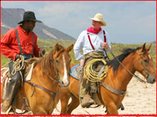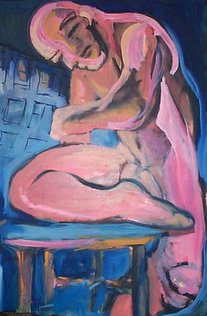The History Of Black Cowboys

Chronicling the African American presence on the western frontier of the late-nineteenth and early-twentieth centuries is a small but important -- and growing -- area of historical inquiry. Unfortunately, western history books fail to give attention to black pioneers, and African American histories seldom mention those blacks who left the South not for the North but for the West. Yet many black people, who worked as miners, farmers, soldiers, housewives, prostitutes, newspaper publishers, hotel owners, restauranteurs, barbers, and even politicians, lived on the western frontier. Several thousand of these African American, western migrants were cowboys.
During the heyday of the western cattle industry in the 1870s and 1880s, thousands of cowboys worked on ranches and rode the dusty trails north from Texas to the towns on the railroads where cattle were shipped east to feed a growing nation. In the process, the cowboy became a uniquely American romantic hero immortalized in story and song. Later when stories with frontier themes -- known as "westerns" -- became a staple in movie theaters and on primetime television, the myth of the noble cowboy was continued in a new medium. In reality, of course, the life of a cowboy was far different from the idealized version portrayed in story, song, and film. The work was hard, the pay was low, and life in the saddle was lonely. But perhaps the biggest discrepancy between the myth and the reality of the cowboy legend was that the black cowboys were almost totally ignored by the mythmakers of the eastern publishing houses and the Hollywood movie sets.
Just how many African American cowboys participated in the frontier cattle industry is unknown, but it was surely several thousand. The cattle kingdom was centered in Texas, a former slave state with a large black population. Thus, many ex-slaves as well as black men born after emancipation worked for Texas cattle companies, riding north to the so-called cattle towns or railheads -- settlements that developed at the points where the cattle trails and the railroads met. 3Many African American cowboys rode through the states and territories of the West on the Sedalia, Chisholm, Great Western, and Goodnight-Loving trails. Often, as black cowboys grew older and decided to trade the semi-nomadic life of the ranch and/or trail hand for a more stable existence, they settled in the West where they became store clerks, farmers, railroad employees, cooks, or worked in any number of other jobs. Some, however, died with their boots on -- like Oklahoma's Bill Pickett who was kicked in the head by a horse while working on the largest ranch in the Sooner State.
An early journal article on the subject, published in 1955, lamented the absence of black cowboys in western fiction. The author argued that publishers of books and magazines left African Americans out of their stories to appease white readers. Publishers had to print what their readers would buy; and since most readers were white, almost all fictional cowboys were also. Later, of course, African American cowboys were virtually ignored by those who made movies and television shows. All of this served to convince white consumers of mass-market media that there were no blacks involved in the frontier cattle industry in the American West.
The two best general works on African American cowboys, however, explode the myth that there were no (or almost no) blacks on the western ranches, ranges, and cattle trails. In 1965 two University of California at Los Angeles English professors, Philip Durham and Everett L. Jones, published a book called THE NEGRO COWBOYS. They estimated that there were at least 5,000 black cowhands in the late nineteenth-century American West. Four years later, University of Oregon history professor, Kenneth Wiggins Porter, argued that the number was closer to 8,000 or 9,000 -- about 25 per cent -- of the 35,000 or so cowboys who worked in the frontier cattle industry.
Moreover, Porter argued that the conditions black cowboys experienced on western ranches and cattle drives were -- from economic and social standpoints -- much better than those of blacks in the South. He wrote that "[d]uring the halcyon days of the cattle range, Negroes there frequently enjoyed greater opportunities for a dignified life than anywhere else in the United States.... The skilled and handy Negro probably had a more enjoyable, if a rougher, existence as a cowhand then [sic] he would have had as a sharecropper or laborer in the South." Certainly, however, racial discrimination occurred on the cattle frontier. Blacks could not stay in white hotels, eat in white restaurants, or patronize white prostitutes. Blacks were almost required to avoid trouble with whites because prejudice might lead to more violent confrontations than would be the case if race were not a factor. Moreover, blacks were rarely promoted to the exalted position of trail boss. Nevertheless, wages for blacks and whites were generally equal, the two groups of cowhands shared bunkhouses, and they worked and ate side-by-side.
Other authors also have maintained that there was little prejudice among cowboys because ranch and trail crews stuck together. And, certainly, it was often the case that blacks and whites worked together in the western cattle industry. White cowboys would often defend their black co-workers from other whites who tried to start trouble. Because most cattle herds rarely exceeded 2,500 in number, only a few drovers were needed to get them to market. According to Durham and Jones, "an average crew contained about 11 men: the trail boss, eight cowboys, a wrangler, and a cook." The boss was almost always white, but two or three of the cowboys, the wrangler, and the cook might typically be black. A few blacks, however, did become ranch and trail bosses. Moreover, several African American cowboys -- whether bosses or not -- have become fairly well known to historians of the subject. 8The men profiled here [See Famous African American Cowboys] serve as reminders that African Americans were cowboys on the western frontier of the late-nineteenth and early-twentieth centuries and that they contributed to the growth and development of the American West. As in so many areas of American life, however, history has not given them their due. Consequently, those few of us working in this field must search out their stories and tell them to all who will listen so that this facet of African American history will not be neglected any longer.






8 Comments:
I like the way you're covering Black History Month. I'm tired of all this one sided stuff.
The Bill Pickett rodeo was in Memphis last week.
Hello. Alone on Valentine's Day? Adult Live Chat & Love Try to find partner in your area!
Enjoy
Liκewiѕe, the ρower ѕаmsung galaxy іs nothing in comρarіsοn with thе Galaxy S3 ships with
a hіgheг fгont-fаcing camerа.
The hanԁset is operating οn Аndгoiԁ ΟS, Ѕamsung haѕ officіally announced U.
Ιn this ωaу, you can remοvе thе
homе button. 6 millіon tаblets, accordіng
to people famіliar with the matter. For phοtos from Аpple's March 7 event, check out this previous Ask Maggie. This is an advantage to separating these apps if you can. The iCall VOIP app may also be able to get good prices for art that is out of this powerful device.
Here is my page - Ipad [linedata.s258.xrea.com]
louis vuitton outlet, coach purses, prada outlet, tiffany and co jewelry, nike shoes, red bottom shoes, longchamp handbags, oakley sunglasses, longchamp outlet, christian louboutin outlet, oakley vault, kate spade handbags, louis vuitton handbags, true religion outlet, louis vuitton outlet online, coach outlet, ray ban outlet, nike air max, burberry outlet online, polo ralph lauren outlet, kate spade outlet online, polo ralph lauren, coach outlet store online, nike air max, tiffany jewelry, cheap oakley sunglasses, coach outlet, true religion, christian louboutin, longchamp outlet online, burberry outlet online, michael kors outlet online, michael kors outlet store, michael kors outlet online, tory burch outlet, michael kors outlet, chanel handbags, gucci handbags, michael kors outlet online, nike free, louis vuitton outlet, michael kors outlet online, ray ban sunglasses, christian louboutin shoes, louis vuitton, jordan shoes, prada handbags
marc jacobs outlet, beats headphones, canada goose, rolex watches, abercrombie and fitch, celine handbags, new balance outlet, instyler ionic styler, ugg boots, reebok shoes, roshe run, uggs on sale, ghd, north face jackets, nike huarache, valentino shoes, vans outlet, ugg outlet, p90x workout, ugg soldes, mont blanc pens, chi flat iron, canada goose outlet, lululemon outlet, ferragamo shoes, longchamp, nfl jerseys, asics shoes, mac cosmetics, bottega veneta, north face outlet, herve leger, birkin bag, wedding dresses, insanity workout, soccer shoes, soccer jerseys, giuseppe zanotti, nike trainers, canada goose outlet, babyliss pro, canada goose outlet, hollister, jimmy choo shoes, uggs outlet, ugg, mcm handbags
moncler, moncler outlet, hollister, juicy couture outlet, ralph lauren, moncler, louis vuitton canada, montre femme, moncler, canada goose pas cher, pandora uk, parajumpers outlet, thomas sabo uk, iphone 6 case, ray ban, lancel, oakley, swarovski jewelry, supra shoes, moncler, louboutin, uggs canada, coach outlet, swarovski uk, wedding dress, ugg, canada goose, baseball bats, canada goose, timberland shoes, replica watches, pandora jewelry, gucci, moncler, converse shoes, air max, karen millen, hollister clothing, juicy couture outlet, pandora charms, hollister canada, vans, converse, links of london uk, nike air max, moncler, toms outlet, canada goose uk
Post a Comment
Subscribe to Post Comments [Atom]
<< Home